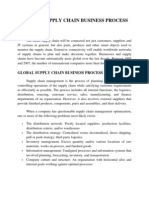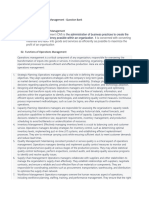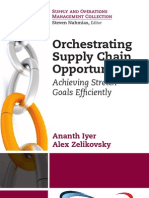0 ratings0% found this document useful (0 votes)
28 viewsSCM Highlight
The document discusses operations management and supply chain management. It defines the key aspects of each, including that operations management focuses on internal processes while supply chain management coordinates activities across the entire network. The document also outlines various strategies, processes, and tools used in operations and supply chain management like capacity planning, logistics approaches, roadmaps, and workflow charts.
Uploaded by
NguyenCopyright
© © All Rights Reserved
Available Formats
Download as DOCX, PDF, TXT or read online on Scribd
0 ratings0% found this document useful (0 votes)
28 viewsSCM Highlight
The document discusses operations management and supply chain management. It defines the key aspects of each, including that operations management focuses on internal processes while supply chain management coordinates activities across the entire network. The document also outlines various strategies, processes, and tools used in operations and supply chain management like capacity planning, logistics approaches, roadmaps, and workflow charts.
Uploaded by
NguyenCopyright
© © All Rights Reserved
Available Formats
Download as DOCX, PDF, TXT or read online on Scribd
You are on page 1/ 6
1. What is Operations Management and how is it different from Supply Chain?
Operations Management and Supply Chain Management are two
interrelated but distinct areas of management that are critical to the success of any
organization. Operations Management (OM) is concerned with managing the
processes that create and deliver a company's products or services. OM focuses on
the design, control, and improvement of these processes, to maximize efficiency,
quality, and customer satisfaction. It includes activities such as production
planning and control, inventory management, quality control, and process
improvement.
Supply Chain Management (SCM), on the other hand, is concerned with
managing the flow of materials, information, and funds across the entire network
of suppliers, manufacturers, distributors, and customers involved in the product or
service creation and delivery. SCM focuses on managing relationships and
coordinating activities across this network, to create a seamless flow of goods and
information from raw materials to end customers. It includes activities such as
procurement, logistics, and demand forecasting.
In summary, Operations Management is focused on managing the internal
processes of an organization, while Supply Chain Management is focused on
managing the entire network of organizations involved in the creation and delivery
of a product or service. While both areas are critical to the success of an
organization, they serve different purposes and require different skill sets and
approaches.
2. What are some of the key elements of Operations Management in Business?
The key elements of Operations Management in a business include:
a. Process Design: The design of the processes used to create and deliver
products or services, including the selection of technology, the layout of
facilities, and the flow of materials and information.
b. Capacity Planning: The determination of the production capacity
required to meet the demand for a product or service, taking into
account factors such as equipment availability, labor availability, and
lead times.
c. Inventory Management: The management of raw materials, work-in-
progress, and finished goods inventory to ensure that sufficient
quantities are available to meet demand while minimizing holding costs.
d. Quality Control: The monitoring and control of product or service
quality to ensure that it meets or exceeds customer expectations.
e. Scheduling: The coordination of production activities to ensure that raw
materials, components, and finished goods are available when needed to
meet production and customer demand.
f. Supply Chain Management: The management of the flow of materials,
information, and funds across the entire network of suppliers,
manufacturers, distributors, and customers involved in the creation and
delivery of a product or service.
3. What are the main strategies in logistics for Supply Chain?Explain in what
consists one of them.
Logistics is a critical component of Supply Chain Management (SCM) and
plays a key role in determining the efficiency, responsiveness, and overall success
of a supply chain. There are several strategies that organizations can employ in
logistics to improve their supply chain performance, including:
a. Just-in-Time (JIT) Logistics: This strategy focuses on reducing
inventory levels and improving delivery speed and accuracy by
delivering goods just in time for them to be used in the production
process or sold to customers. JIT requires close coordination between
suppliers, manufacturers, and distributors to ensure that the right goods
are delivered to the right place at the right time.
b. Cross-Docking: This strategy involves the consolidation of goods from
multiple suppliers into a single shipment, which is then distributed
directly to retailers or customers without being stored in a warehouse.
This can reducelead times and minimize inventory holding costs, but
requires close coordination between suppliers, logistics providers, and
customers.
c. Reverse Logistics: This strategy involves the management of returns,
repairs, and disposal of goods that have reached the end of their useful
life. Reverse logistics is becoming increasingly important as companies
strive to minimize waste and maximize the value of their products.
d. Lean Logistics: This strategy is based on the principles of lean
manufacturing and focuses on reducing waste and maximizing
efficiency in the supply chain. Lean logistics involves identifying and
eliminating non-value- adding activities, streamlining processes, and
implementing continuous improvement practices.
e. Third-Party Logistics (3PL): This strategy involves outsourcing all or
part of a company's logistics operations to a third-party provider, who is
responsible for managing the movement of goods, storage, and
transportation. This approach can reduce costs and improve efficiency
by leveraging the expertise and resources of the 3PL provider.
4. What is capacity planning for products and services?
Capacity planning is a key element of Operations Management that
involves determining the production capacity required to meet the demand for a
product or service. The goal is to ensure that the production capacity is aligned
with demand so that it can meet customer needs in a timely and efficient manner.
This involves considering factors such as:
a. Equipment availability: The availability of the machinery and equipment
needed to produce a product or provide a service.
b. Labor availability: The availability of the personnel needed to operate the
machinery and equipment and carry out the production process.
c. Lead times: The time required to acquire raw materials, components, or
finished goods from suppliers.
d. Seasonal fluctuations: Changes in demand that occur as a result of seasonal
factors such as holidays or weather patterns. Based on this information,
capacity planning enables organizations to determine the optimal level of
production capacity required to meet demand, while also considering
factors such as the cost of unused capacity and the impact of excess
inventory.
5. What is a road map in Operations and Supply Chain Management and how is it
relevant for business success?
A roadmap in Operations and Supply Chain Management is a visual
representation of the key initiatives and actions that an organization plans to
undertake over a specified period, typically several years, to achieve its strategic
goals in these areas. It outlines the steps that the organization will take to improve
its operations, supply chain, and logistics processes, and achieve its goals in terms
of efficiency, cost savings, quality, customer satisfaction, and other key
performance indicators.
It provides a timeline that identifies the expected start and end dates for
each initiative, as well as the resources required, including personnel, equipment,
and funding. It also identifies the key milestones that the organization needs to
achieve along the way and the dependencies and risks associated with each
initiative.
A roadmap is essential for business success as it provides a clear direction
and focus for the organization, enabling it to prioritize its efforts and allocate its
resources effectively. By having a roadmap in place, organizations can ensure that
they are making the right investments in their operations and supply chain and that
they are focused on the initiatives that will have the greatest impact on their
performance.
In addition, it provides transparency and accountability, enabling the
organization to track progress, make mid- course corrections, and communicate its
plans and results to stakeholders. This helps to build trust and confidence in the
organization and strengthens its relationships with suppliers, customers, and other
key stakeholders.
6. What is a workflow chart and how is it important for business planning purposes?
A workflow chart is a visual representation of a set of tasks or processes
involved in completing a specific project or achieving a particular goal. It is used
to understand the steps involved in a process, the dependencies between tasks, and
the flow of work from start to finish. It typically shows the sequence of tasks
involved in a process, along with the roles and responsibilities of each team
member involved. It also identifies decision points, approvals, and feedback loops
that are built into the process.
The importance of a workflow chart for business planning purposes lies in
its ability to provide a clear understanding of the process and help identify areas
for improvement. By creating a visual representation of the process, organizations
can clarify the process so everyone involved has a common understanding of the
steps involved and the expectations for each task. They can identify inefficiencies
in the process such as bottlenecks, long wait times, or redundant steps. They can
streamline processes by identifying areas for improvement thereby reducing waste,
cutting costs, and improving overall efficiency.
A workflow chart can help to improve collaboration between team
members, by making it clear who is responsible for each task and when each task
should be completed. It is a useful tool for communicating process information to
stakeholders, including employees, customers, and suppliers.
7. Choose just one of the following productivity management components and
provide an example of your work experience/ own research, on how this
management element contributed or contributes to the profitability of your
business (or researched business):
Inventory management Inventory management plays a crucial role in
contributing to a company's profitability. By managing inventory effectively, a
business can:
a. Reduce inventory costs: Effective inventory management can help to
reduce the costs associated with holding and managing inventory, such
as storage costs, insurance costs, and carrying costs.
b. Improve customer satisfaction: Inventory management helps to ensure
that the right products are available in the right quantities, at the right
time, to meet customer demand. This can help to improve customer
satisfaction and reduce the risk of lost sales due to stockouts.
c. Increase efficiency: Effective inventory management can help to
improve the efficiency of operations by reducing the time and resources
required to manage inventory and freeing up resources for other
activities.
d. Reduce waste: Inventory management can help to reduce waste by
avoiding overstocking, which can lead to obsolete inventory, or
understocking, which can result in stockouts.
e. Enhance financial performance: Effective inventory management can
help to enhance the financial performance of a company by reducing
costs, improving customer satisfaction, and increasing efficiency, all of
which contribute to higher profitability.
You might also like
- Operations Management For Supply Chain Decisions17% (6)Operations Management For Supply Chain Decisions25 pages
- ITT Understanding Freight Forwarding Part 1No ratings yetITT Understanding Freight Forwarding Part 16 pages
- Bill of Lading: PO Box 17000 Dubai United Arab Emirates 971 4 8811110100% (1)Bill of Lading: PO Box 17000 Dubai United Arab Emirates 971 4 88111101 page
- 204 Operation & Supply Chain Management Model AnsNo ratings yet204 Operation & Supply Chain Management Model Ans17 pages
- 204 Operations and Supply Chain ManagementNo ratings yet204 Operations and Supply Chain Management33 pages
- Strategic Management Process Has Following Four Steps:: Environmental ScanningNo ratings yetStrategic Management Process Has Following Four Steps:: Environmental Scanning12 pages
- Material and Inventory Management: Types of Production PlanningNo ratings yetMaterial and Inventory Management: Types of Production Planning11 pages
- Opm549 Individual Assignment 2 - Muhd Adib Bin Daman Huri 2021239468No ratings yetOpm549 Individual Assignment 2 - Muhd Adib Bin Daman Huri 202123946814 pages
- Bms 830 Supply Chain Optimization - Gloria C-WPS OfficeNo ratings yetBms 830 Supply Chain Optimization - Gloria C-WPS Office16 pages
- Business-Process Integration: Supply-Chain Management 2.0 (SCM 2.0)No ratings yetBusiness-Process Integration: Supply-Chain Management 2.0 (SCM 2.0)8 pages
- Sourcing - Logistics - LEC01 04102023 064133pmNo ratings yetSourcing - Logistics - LEC01 04102023 064133pm31 pages
- Assignment Supply Chain Management BY Virupaksha Reddy.T ROLL NUMBER: 510916226 OM0003 SET-1No ratings yetAssignment Supply Chain Management BY Virupaksha Reddy.T ROLL NUMBER: 510916226 OM0003 SET-112 pages
- Operation and Supply Chain Strategies - Kumar AnimeshNo ratings yetOperation and Supply Chain Strategies - Kumar Animesh6 pages
- Definition and Basic Concepts of Operations ManagementNo ratings yetDefinition and Basic Concepts of Operations Management8 pages
- How Do Supply Chain Management Systems Coordinate Planning, Production and Logistics With Suppliers?No ratings yetHow Do Supply Chain Management Systems Coordinate Planning, Production and Logistics With Suppliers?4 pages
- Supply Chain Management - Key Terms: AgreementsNo ratings yetSupply Chain Management - Key Terms: Agreements7 pages
- Military Supply Chain Management: From Deployment to Victory, Mastering the Logistics DanceFrom EverandMilitary Supply Chain Management: From Deployment to Victory, Mastering the Logistics DanceNo ratings yet
- Evolving Management Practices: Navigating the Modern Business LandscapeFrom EverandEvolving Management Practices: Navigating the Modern Business LandscapeNo ratings yet
- Chap 3 - Purchasing and Supply ManagementNo ratings yetChap 3 - Purchasing and Supply Management14 pages
- Beige Brown Aesthetic Polaroid Frame Photo Instagram StoryNo ratings yetBeige Brown Aesthetic Polaroid Frame Photo Instagram Story5 pages
- Situation Analysis Report:: Heineken Vietnam Brewery BeerNo ratings yetSituation Analysis Report:: Heineken Vietnam Brewery Beer14 pages
- Integrated Management System (IMS) ManualNo ratings yetIntegrated Management System (IMS) Manual46 pages
- Orchestrating Supply Chain Opportunities: Achieving Stretch Goals EfficientlyNo ratings yetOrchestrating Supply Chain Opportunities: Achieving Stretch Goals Efficiently22 pages
- The Essential Guide To Third Party Logistics: What Is A 3PL, Considerations For Hiring, & How To Select & Implement A 3PLNo ratings yetThe Essential Guide To Third Party Logistics: What Is A 3PL, Considerations For Hiring, & How To Select & Implement A 3PL92 pages
- 2022 - Demand - IEX - Risk Management - EbookNo ratings yet2022 - Demand - IEX - Risk Management - Ebook11 pages
- What Is The Difference Between 1PL, 2PL, 3PL, 4PL and 5PL Logistics100% (2)What Is The Difference Between 1PL, 2PL, 3PL, 4PL and 5PL Logistics2 pages
- 50 Wholesale Platforms To Sell Products in The USANo ratings yet50 Wholesale Platforms To Sell Products in The USA9 pages
- Blockchain Technology-Based Agri-Food Supply Chain SystemNo ratings yetBlockchain Technology-Based Agri-Food Supply Chain System7 pages
- 48-49 Transportation and Warehousing in The US Industry ReportNo ratings yet48-49 Transportation and Warehousing in The US Industry Report46 pages
- Forklift Turning Radius & Aisle Requirements - RecommedationsNo ratings yetForklift Turning Radius & Aisle Requirements - Recommedations8 pages
- Bill of Lading: Semarang, Indonesia Semarang, Indonesia Sinar Sunda 041 Hamad Port, Qatar Hamad Port, QatarNo ratings yetBill of Lading: Semarang, Indonesia Semarang, Indonesia Sinar Sunda 041 Hamad Port, Qatar Hamad Port, Qatar1 page
- Application of Operation Research in Logistics and Warehouse OptimizationNo ratings yetApplication of Operation Research in Logistics and Warehouse Optimization10 pages
- Personal Information: Name: Sagar Kumar Phone Number: 4164742882No ratings yetPersonal Information: Name: Sagar Kumar Phone Number: 41647428827 pages
- Warehouse Location and Factors Affecting ItNo ratings yetWarehouse Location and Factors Affecting It10 pages
- Storage and Warehousing Techniques: LinksNo ratings yetStorage and Warehousing Techniques: Links21 pages
- Study Plan - Logistic Sciences 2018-2019No ratings yetStudy Plan - Logistic Sciences 2018-20195 pages
- Bill of Lading: PO Box 17000 Dubai United Arab Emirates 971 4 8811110Bill of Lading: PO Box 17000 Dubai United Arab Emirates 971 4 8811110
- Strategic Management Process Has Following Four Steps:: Environmental ScanningStrategic Management Process Has Following Four Steps:: Environmental Scanning
- Material and Inventory Management: Types of Production PlanningMaterial and Inventory Management: Types of Production Planning
- Opm549 Individual Assignment 2 - Muhd Adib Bin Daman Huri 2021239468Opm549 Individual Assignment 2 - Muhd Adib Bin Daman Huri 2021239468
- Bms 830 Supply Chain Optimization - Gloria C-WPS OfficeBms 830 Supply Chain Optimization - Gloria C-WPS Office
- Business-Process Integration: Supply-Chain Management 2.0 (SCM 2.0)Business-Process Integration: Supply-Chain Management 2.0 (SCM 2.0)
- Assignment Supply Chain Management BY Virupaksha Reddy.T ROLL NUMBER: 510916226 OM0003 SET-1Assignment Supply Chain Management BY Virupaksha Reddy.T ROLL NUMBER: 510916226 OM0003 SET-1
- Operation and Supply Chain Strategies - Kumar AnimeshOperation and Supply Chain Strategies - Kumar Animesh
- Definition and Basic Concepts of Operations ManagementDefinition and Basic Concepts of Operations Management
- How Do Supply Chain Management Systems Coordinate Planning, Production and Logistics With Suppliers?How Do Supply Chain Management Systems Coordinate Planning, Production and Logistics With Suppliers?
- Military Supply Chain Management: From Deployment to Victory, Mastering the Logistics DanceFrom EverandMilitary Supply Chain Management: From Deployment to Victory, Mastering the Logistics Dance
- Evolving Management Practices: Navigating the Modern Business LandscapeFrom EverandEvolving Management Practices: Navigating the Modern Business Landscape
- Beige Brown Aesthetic Polaroid Frame Photo Instagram StoryBeige Brown Aesthetic Polaroid Frame Photo Instagram Story
- Situation Analysis Report:: Heineken Vietnam Brewery BeerSituation Analysis Report:: Heineken Vietnam Brewery Beer
- Orchestrating Supply Chain Opportunities: Achieving Stretch Goals EfficientlyOrchestrating Supply Chain Opportunities: Achieving Stretch Goals Efficiently
- The Essential Guide To Third Party Logistics: What Is A 3PL, Considerations For Hiring, & How To Select & Implement A 3PLThe Essential Guide To Third Party Logistics: What Is A 3PL, Considerations For Hiring, & How To Select & Implement A 3PL
- What Is The Difference Between 1PL, 2PL, 3PL, 4PL and 5PL LogisticsWhat Is The Difference Between 1PL, 2PL, 3PL, 4PL and 5PL Logistics
- 50 Wholesale Platforms To Sell Products in The USA50 Wholesale Platforms To Sell Products in The USA
- Blockchain Technology-Based Agri-Food Supply Chain SystemBlockchain Technology-Based Agri-Food Supply Chain System
- 48-49 Transportation and Warehousing in The US Industry Report48-49 Transportation and Warehousing in The US Industry Report
- Forklift Turning Radius & Aisle Requirements - RecommedationsForklift Turning Radius & Aisle Requirements - Recommedations
- Bill of Lading: Semarang, Indonesia Semarang, Indonesia Sinar Sunda 041 Hamad Port, Qatar Hamad Port, QatarBill of Lading: Semarang, Indonesia Semarang, Indonesia Sinar Sunda 041 Hamad Port, Qatar Hamad Port, Qatar
- Application of Operation Research in Logistics and Warehouse OptimizationApplication of Operation Research in Logistics and Warehouse Optimization
- Personal Information: Name: Sagar Kumar Phone Number: 4164742882Personal Information: Name: Sagar Kumar Phone Number: 4164742882























































































































